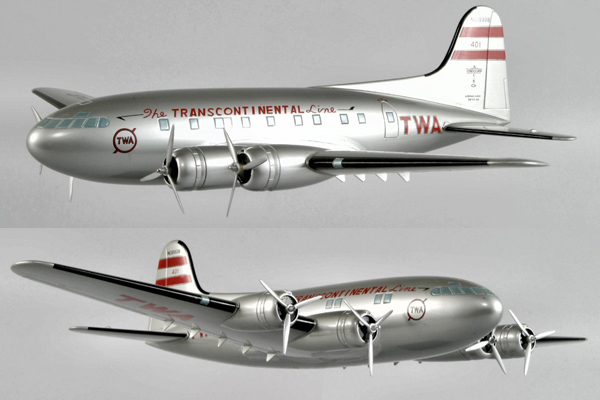TWA Boeing 307 Stratoliner

MODEL BY:
Trans World Airlines
Model Scale:
1/72
MODEL ADDED:
08/30/1966
historical significance
First Albuquerque Visit: 1940
additional information
The four-engine Boeing 307 “Stratoliner” began service with TWA in 1940. The aircraft were pressurized and could fly at higher altitudes to avoid bad weather and could also fly longer distances cutting down on the number of fuel stops needed. TWA placed the aircraft on their transcontinental route between Los Angeles (Burbank Airport) and New York making only three stops at Albuquerque, Kansas City, and Chicago. Only ten aircraft were built with five purchased by TWA, four by Pan American Airways, and the last one was bought by Howard Hughes who was planning to use it for an around the world flight. The very first aircraft completed, registration NX19901, crashed on March 18, 1939, during a test flight to measure flight control forces.
TWA was the first and only company to have operated the four-engine airliner over domestic routes when the United States entered World War II in 1942. TWA was asked by Army Air Forces General “Hap” Arnold in the early 1940’s to train pilots to fly four engine aircraft. TWA selected Kirtland Army Air Field (now Kirtland Air Force Base) as the location for the school. The school was called the Four Engine School but also became known as the “Jack Frye School” and was popularly called the “Eagle’s Nest Flght Center”. Along with U.S. pilots, TWA also trained British flying boat pilots in flying large aircraft. The TWA Boeing 307’s along with Consolidated B-24’s were also used in the initial phase of crew and bombardier training at the Kirtland Field from 1942 to 1943. When the war started, the Boeing 307’s were inducted into the Army as C-75’s. The five TWA planes were under the Army’s Air Transport Command and flown all around the world supporting military activities.
In 1944, all five aircraft were returned to TWA and were rebuilt at Boeing with new upgrades to resume passenger flights. By the late 1940’s, TWA replaced the 307’s with the new Lockheed Constellations and the five planes were later sold to other airlines.
TWA had American Indian names for each of their planes:
- NC19905 – Comanche
- NC19906 – Cherokee
- NC19907 – Zuni
- NC19908 – Apache
- NC19909 – Navajo
Only one of the ten planes survives today and was on display in the Pima Air Museum until the late 1980’s. This plane was NC19903 “The Flying Cloud”, one of the four that flew for Pan American Airways.
Boeing repaired the plane to fly it back to the plant in Everett, Washington for a total refurbishing. After completion of the refurbishing, the plane was flown to air shows around the country. While on a flight in the Seattle area on March 28, 2002, the plane ran out of fuel and ditched in Lake Washington where it sank in Elliott Bay. Boeing then retrieved the aircraft and completely restored it once again. When it was once again airworthy, it was flown to Dulles Airport in Washington D.C. and put on display in the Smithsonian Air and Space Museum.
The photos below include two TWA 307’s inflight, a cockpit of a 307, the Howard Hughes plane which carried the civil registration N19904 and was nicknamed “The Flying Penthouse”, a 307 on display at the Smithsonian, and a TWA Boeing 307 parked at the Albuquerque Municipal Airport which was brand new at the time.
GALLERY:
SEARCH OUR DATABASE:
